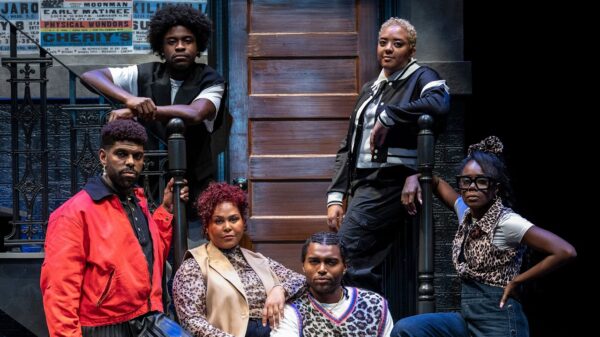The College of Arts and Sciences (COAS) is facing challenges with accommodating students and professors due to the increased number of its enrolled students, which now stands at 3,973 according to Dean Rubin Patterson.
The increase of students has added pressure on COAS faculty, many of them having to take on larger class sizes. Some professors have also taken on the role of advisor, while others have tried to partner with the advisors in the Office of Undergraduate Studies to ensure students are able to graduate on time and share the responsibility of teaching multiple packed classes.
Patterson said that COAS, referred to as “The Flagship” on its website due to it being the “oldest and largest of the University’s 13 schools and colleges,” currently holds approximately one-third of Howard’s student body.
He provided The Hilltop with a table illustrating the growth of the college, which experienced a 35 percent spike in enrollment between 2018 and 2022.
“Approximately one-half of incoming freshmen are enrolled as COAS students,” Patterson said. Acknowledging the current pressure of faculty, he said that “the most immediate impact is the need for additional faculty members to teach a growing student body.”
Foreign language department chair Leonard Muaka is the main point of contact for students who need to enroll in the foreign language courses they need to fulfill graduation requirements.
On Friday, Jan 20, nearing the registration deadline for the spring 2023 semester, many juniors and seniors found themselves lined up outside Muaka’s office hoping to be accommodated, as many foreign language classes were indicated as full on student portal Bisonweb.
“Over the weekend, I was still working on trying to find them seats,” Muaka said.
“By the time you come to the beginning of the semester, already all the seats have been taken and all the faculty have been assigned what is allowed in the faculty handbook,” Muaka added. With students registering as early as October of the previous semester, students who register later are put at a disadvantage.
Muaka was able to help students figure out what course would best fit their needs and encouraged students to email the teacher to request if they would open up a seat for them. The approval from the instructor would then allow Muaka to add a student into a closed course.
Courtney Robinson, an associate professor for more than 10 years and now interim chair of the biology department, has also taken on an additional role as a student advisor. She gave insight into the ways her department is trying to accommodate the increase of its student population.
“Courses where, for example, when I first started was only one section but now we’re offering three sections of that course,” she said. “We’ve had a massive expansion of the general biology series, General Biology 101 and 102, as well as Genetics. We’re offering more courses in that section than we ever have.”
“Sections” refer to the times at which a student has a class. “Courses” refer to a series of classes which could be required to graduate.
Biology is one of the most common majors within COAS, followed by psychology, political science and health/physical education according to Shaunda Young who is an undergraduate advisor and program manager for academic compliance.
Most students enrolled as an undergraduate at Howard take at least one course in COAS due to university-wide requirements. The college also issues requirements to students who major in departments within their own.
Students enrolled in COAS are expected to complete 120 credit hours to earn a bachelor’s degree, with the average class awarding three credits. Though Patterson said the required credit hours will remain the same, he shared that the university was working on a “new General Education curriculum” to be implemented in Fall 2023.
“COAS will also implement its modified college-specific requirements that term,” he said. “These broad changes will result in higher graduation rates, more flexibility in student matriculation, more innovation within curriculums and greater ability to switch majors between colleges and schools and still graduate on-time.”
In addition to COAS, Patterson said that numerous offices are involved in an initiative to expedite and produce the correct complement of classes in succeeding terms: the Offices of the Provost, Enrollment Management, Financial Aid, Chief Financial Officer, Undergraduate Studies, ETS and Human Resources.
A former biology advisor, Young now primarily specializes in clearing seniors for graduation. She believes that some students can do more to focus on solutions to solving their registration problems rather than panicking.
“In my experience, students jump into panic mode after realizing they’re missing a required class instead of focusing on university offered solutions,” she said. Young revealed that students can ask to “substitute” one class for another in the case one of their required classes is full. This can be especially useful for students still completing their divisional requirements.
According to Young, divisionals are based on learning requirements. For example, Division A courses cover arts, humanities, music and classics. If a class in that divisional course is filled, Young suggests students find another course that is similar to the learning requirements of the class, even if the class itself isn’t listed as a divisional.
Though this may work in some cases, it unfortunately does not work for all.
Senior psychology major and legal communication minor from New York, Cyan Fleming, was among many students in COAS who ran into problems during registration.
“It’s usually things like ‘the classes are too full’ or ‘there’s not enough sections,’” she said. As a graduating senior, Fleming was among the first to register in the fall. However, due to the popularity of her major, she struggled to get into her required classes.
The general class registration for the spring semester opened Oct. 31 with plans for late registration to close Jan. 20. The university sent an announcement the morning of Jan. 20 that late registration would be extended until Sunday, Jan. 22. It was on that last day Fleming was able to gain access to her last course needed for graduation, independent research study.
Issues with registration began occurring in early November as students like Alexa Moore, an honors biology major from Houston, began to notice some of the classes she registered for weren’t on her schedule anymore.
“For me, it was my Intro to Ethics class,” Moore said. “I had started noticing when multiple students were mentioning it in [the] GroupMe, which actually prompted me to check my own schedule and see if anything was dropped.”
Similar to Muaka, Young believes the increased interest in HBCUs has led to the Howard enrollment increase.
According to the Howard University admissions page, 29,391 applications were submitted to the University for the class of 2025 with 10,362 of those applications accepted.
The large number of accepted students is the university’s efforts to achieve a large enrollment rate according to their pillar for enhancing academic excellence, which they have surpassed by admitting 10,859 students and have set a new goal of having 12,500 students enrolled by 2024.
“One of the major challenges we faced, which is a really good challenge, is that we’ve grown by 37 percent at the undergraduate level since 2019,” Associate Provost of Undergraduate Studies Kenneth Anderson said.
Anderson said that there are different solutions in place to ease and address the stresses that come with registration.
“If you look sort of nationwide, there’s been a lot of turnover, nationally with faculty,” Anderson said. “And if you look at what Howard has been doing…we’ve been able to attract a lot of students during the pandemic which is the reverse for most universities.”
However, for students like Fleming with popular majors, the increased enrollment paired with stressed faculty and overall miscommunication, makes it harder to smoothly matriculate at Howard.
Fleming pointed to what she said was lack of response from different faculty advisors as the reason why it took her so long to get into the course, saying that at one point she was directed to someone who was no longer working at the university.
The classes perhaps feeling the most impact are juniors and seniors, who are closer to graduation than the sophomores and freshmen and thus might feel a sense of urgency towards ensuring they can walk across the stage.
“We’re all dealing with these changes as best as we can,” Robinson said. “The thing to remember is that we want students to have the best experience they possibly can and we want to do our part to make sure it happens.”
Copy edited by N’dia Webb









